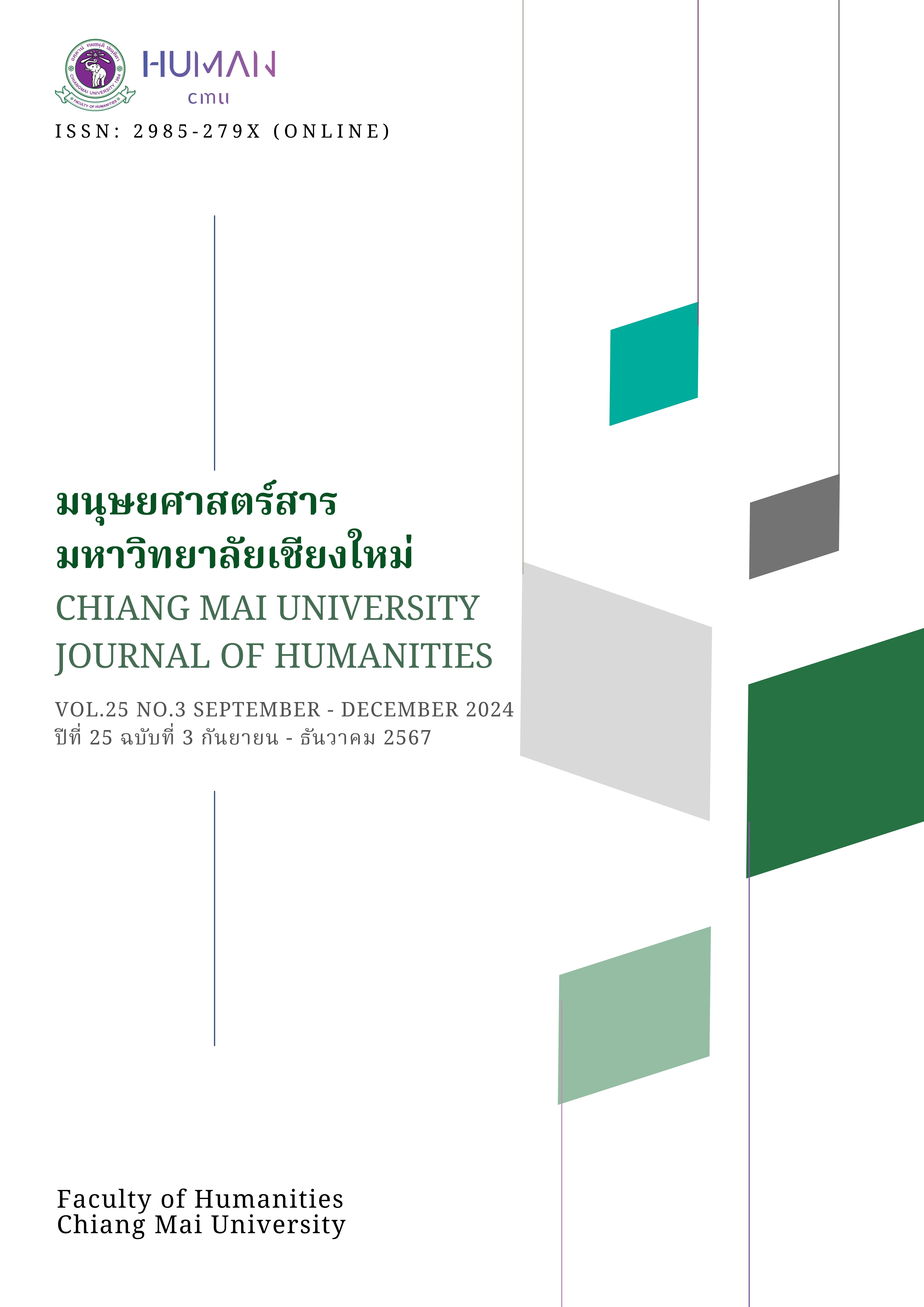ผลกระทบของคำพ้องเสียงจากภาพในภาษาอังกฤษต่อการตัดสินใจของผู้บริโภคชาวไทย
Main Article Content
บทคัดย่อ
การเตรียมการรับรู้ถือเป็นเครื่องมือใช้ชี้นำความคิดของผู้ซื้อในการศึกษาเชิงการตลาด การวิจัยครั้งนี้มุ่งสำรวจการเตรียมการรับรู้ในแง่ของการบูรณาการระหว่างภาษาศาสตร์และการตลาด มีวัตถุประสงค์เพื่อศึกษาผลกระทบของการเตรียมการรับรู้คำพ้องเสียงจากภาพในภาษาอังกฤษต่อการตัดสินใจของผู้บริโภคชาวไทย และเพื่อสำรวจประสิทธิภาพการเตรียมการรับรู้ดังกล่าว โดยเปรียบเทียบกับผลจากผู้พูดภาษาอังกฤษเป็นภาษาแม่ กลุ่มตัวอย่างในการวิจัยคือ คนไทยที่พูดภาษาอังกฤษได้ในระดับกลางขึ้นไป เครื่องมือการทดลองคือการสัมภาษณ์หลังการรับชมภาพโฆษณาที่มีคำพ้องเสียงจากภาพ จำนวน 3 คู่ ได้แก่ “sail-sale” “deer-dear” และ “hole-whole” การศึกษาถูกแบ่งออกเป็น 3 การทดลองสำหรับคำพ้องเสียงแต่ละคู่ที่มีคุณสมบัติที่แตกต่างกันตามความหมาย ผลจากการคำนวณเชิงสถิติพบว่า มีผลกระทบจากการเตรียมการรับรู้ โดยความเต็มใจที่จะจ่ายในคนไทยมีอัตราสูงขึ้นอย่างมีนัยสำคัญเมื่อได้รับตัวกระตุ้นเป็นคำพ้องเสียงจากภาพคู่ที่ 2 และ 3 ได้แก่ “deer-dear” และ “hole-whole” ในคู่ที่ 2 ภาพกวางสามารถกระตุ้นความรู้สึกรักและทำให้เห็นถึงมูลค่าของสินค้า ซึ่งเป็นผลมาจากความหมายเสริมของ “deer” ในคู่ที่ 3 ภาพหลุมสามารถสร้างความรู้สึกของการรวมกันเป็นกลุ่ม จากความหมายเสริมของ “hole” และสามารถโน้มน้าวให้เลือกสินค้าที่เป็นกลุ่มมีจำนวนหลายชิ้นมากกว่าสินค้าแยกชิ้นได้สำเร็จ อย่างไรก็ตาม จากการเปรียบเทียบประสิทธิภาพพบว่า ผลกระทบจากการเตรียมการรับรู้ที่เกิดขึ้นในคนไทยอยู่ในระดับที่ต่ำกว่าผู้ที่พูดภาษาอังกฤษเป็นภาษาแม่ในทุกเงื่อนไข ด้วยปัจจัยด้านการแทรกแซงจากภาษาแม่ และความถี่ของคำ
Article Details

This work is licensed under a Creative Commons Attribution-NonCommercial-NoDerivatives 4.0 International License.
References
Beatty, S. E., & Ferrell, M. E. (1998). Impulse buying: Modeling its precursors. Journal of Retailing, 74(2), 169–191.
Brysbaert, M., Mandera, P., & Keuleers, E. (2018). The word frequency effect in word processing: A review update. Current Directions in Psychological Science. 27. 10.1177/0963721417727521.
Christakis, N. A. (2012). Holism. In: Brockman J., editor. This will Make you Smarter: New Scientific Concepts to Improve your Thinking. Harper; New York. pp. 81–83.
Cook, V. (2003). Effects of the Second Language on the First. Clevedon: Multilingual Matters
Davis, D. F., & Herr, P. M. (2014). From Bye to Buy: Homophones as a Phonological Route to Priming. Journal of Consumer Research, 40(6), 1063–1077. https://doi.org/10.1086/673960
Ferrand, L., & Grainger, J. (1992). Phonology and orthography in visual word recognition: Evidence from masked non-word priming. The Quarterly Journal of Experimental Psychology A: Human Experimental Psychology, 45A(3), 353–372.
Hanaysha, J. R. (2018). An examination of the factors affecting consumer’s purchase decision in the Malaysian retail market, PSU Research Review, 2(1), 7-23.
Higgins, E. T. (1996). Knowledge activation: Accessibility, applicability, and salience. In E. Higgins & A. W.
Huang, X. (2017). The role of word frequency and contextual diversity in visual word recognition: a mini review. New Frontiers in Ophthalmology. 3. 10.15761/NFO.1000185.
Joordens, S., & Besner, D. (1994). When banking on meaning is not (yet) money in the bank: Explorations in connectionist modeling. Journal of Experimental Psychology: Learning, Memory, and Cognition, 20(5), 1051–1062.
Kannaovakun, P., & Gunther, A. C. (2003). The mixing of English and Thai in Thai television programs. Manusya: Journal of Humanities, 6(2), 66–80. Retrieved from http://www.manusya.journals.chula.ac.th/files/essay/Prathana_66-80.pdf
Kim, J., & Lennon, S. J. (2013). Effects of reputation and website quality on online consumers' emotion, perceived risk and purchase intention: Based on the stimulus-organismresponse model. Journal of Research in Interactive Marketing, 7(1), 33-56.
Kulczynski, A., Ilicic, J., & Baxter, S. (2017). Pictures are Grate! Examining the effectiveness of pictorial- based homophones on consumer judgments. International Journal of Research in Marketing. 34. 286-301.
Livingcost.org (2024, March 1). International Cost of Living. Https://Livingcost.org/. Retrieved March 3, 2024, from https://livingcost.org/
Locker, L., Simpson, G., & Yates, M. (2003). Semantic neighborhood effects on the recognition of ambiguous words. Memory & cognition. 31. 505-15.
Lukatela, G., & Turvey, M. T. (1994). Visual lexical access is initially phonological: I. Evidence from associative priming by words, homophones, and pseudohomophones. Journal of Experimental Psychology: General, 123(2), 107–128.
Nakai, S., Lindsay, S. & Ota, M. (2014). A prerequisite to L1 homophone effects in L2 spoken word recognition, Second Language Research, 30(3), 1-23.
Oxford University Press. (n.d.). Oxford Advanced Learner’s Dictionary. Retrieved May 18, 2024, from https://www.oxfordlearnersdictionaries.com/
Paivio, A. (1978). The relationship between verbal and perceptual codes. In E. C. Carterette and M.P. Friedman (Eds.), Handbook of perception: Perceptual processing. New York: Academic Press.
Pexman, P. M., Lupker, S. J., & Hino, Y. (2002). The impact of feedback semantics in visual word recognition: Number-of-features effects in lexical decision and naming tasks. Psychonomic Bulletin & Review, 9, 542-549.
Prasithrathsint, A., Rhekhalilit, K., Thongneum, K., Charunrochana, J., & Chanyeam, C. (2019). Language situation in Thailand: the roles of the national and the international languages. Chulalongkorn University Press.
Rosch, E. (1975). Cognitive representations of semantic categories. Journal of Experimental Psychology: General, 104, 192-233.
Simpson, G. B. (1994). Context and the processing of ambiguous words. In M. A. Gernsbacher (Ed.), Handbook of psycholinguistics (pp. 359–374). Academic Press.

